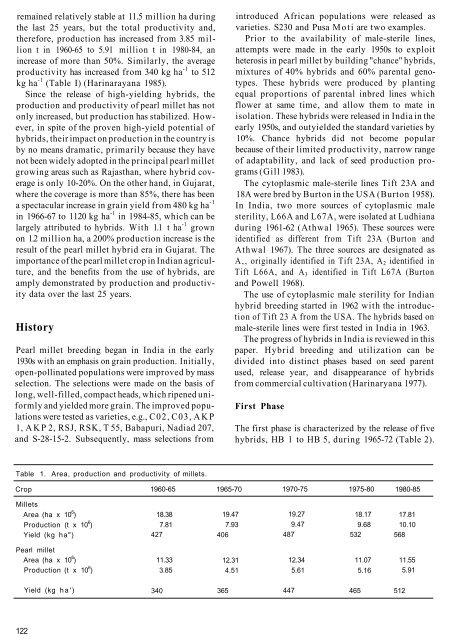RA 00110.pdf - OAR@ICRISAT
RA 00110.pdf - OAR@ICRISAT
RA 00110.pdf - OAR@ICRISAT
Create successful ePaper yourself
Turn your PDF publications into a flip-book with our unique Google optimized e-Paper software.
emained relatively stable at 11.5 million ha during<br />
the last 25 years, but the total productivity and,<br />
therefore, production has increased from 3.85 million<br />
t in 1960-65 to 5.91 million t in 1980-84, an<br />
increase of more than 50%. Similarly, the average<br />
productivity has increased from 340 kg ha -1 to 512<br />
kg ha -1 (Table I) (Harinarayana 1985).<br />
Since the release of high-yielding hybrids, the<br />
production and productivity of pearl millet has not<br />
only increased, but production has stabilized. However,<br />
in spite of the proven high-yield potential of<br />
hybrids, their impact on production in the country is<br />
by no means dramatic, primarily because they have<br />
not been widely adopted in the principal pearl millet<br />
growing areas such as Rajasthan, where hybrid coverage<br />
is only 10-20%. On the other hand, in Gujarat,<br />
where the coverage is more than 85%, there has been<br />
a spectacular increase in grain yield from 480 kg ha -1<br />
in 1966-67 to 1120 kg ha -1 in 1984-85, which can be<br />
largely attributed to hybrids. With 1.1 t ha -1 grown<br />
on 1.2 million ha, a 200% production increase is the<br />
result of the pearl millet hybrid era in Gujarat. The<br />
importance of the pearl millet crop in Indian agriculture,<br />
and the benefits from the use of hybrids, are<br />
amply demonstrated by production and productivity<br />
data over the last 25 years.<br />
History<br />
Pearl millet breeding began in India in the early<br />
1930s with an emphasis on grain production. Initially,<br />
open-pollinated populations were improved by mass<br />
selection. The selections were made on the basis of<br />
long, well-filled, compact heads, which ripened uniformly<br />
and yielded more grain. The improved populations<br />
were tested as varieties, e.g., C02, C03, A K P<br />
1, A K P 2, RSJ, RSK, T 55, Babapuri, Nadiad 207,<br />
and S-28-15-2. Subsequently, mass selections from<br />
introduced African populations were released as<br />
varieties. S230 and Pusa M o t i are two examples.<br />
Prior to the availability of male-sterile lines,<br />
attempts were made in the early 1950s to exploit<br />
heterosis in pearl millet by building "chance" hybrids,<br />
mixtures of 40% hybrids and 60% parental genotypes.<br />
These hybrids were produced by planting<br />
equal proportions of parental inbred lines which<br />
flower at same time, and allow them to mate in<br />
isolation. These hybrids were released in India in the<br />
early 1950s, and outyielded the standard varieties by<br />
10%. Chance hybrids did not become popular<br />
because of their limited productivity, narrow range<br />
of adaptability, and lack of seed production programs<br />
(Gill 1983).<br />
The cytoplasmic male-sterile lines Tift 23A and<br />
18A were bred by Burton in the USA (Burton 1958).<br />
In India, two more sources of cytoplasmic male<br />
sterility, L66A and L67A, were isolated at Ludhiana<br />
during 1961-62 (Athwal 1965). These sources were<br />
identified as different from Tift 23A (Burton and<br />
Athwal 1967). The three sources are designated as<br />
A,, originally identified in Tift 23A, A 2 identified in<br />
Tift L66A, and A 3 identified in Tift L67A (Burton<br />
and Powell 1968).<br />
The use of cytoplasmic male sterility for Indian<br />
hybrid breeding started in 1962 with the introduction<br />
of Tift 23 A from the USA. The hybrids based on<br />
male-sterile lines were first tested in India in 1963.<br />
The progress of hybrids in India is reviewed in this<br />
paper. Hybrid breeding and utilization can be<br />
divided into distinct phases based on seed parent<br />
used, release year, and disappearance of hybrids<br />
from commercial cultivation (Harinaryana 1977).<br />
First Phase<br />
The first phase is characterized by the release of five<br />
hybrids, HB 1 to HB 5, during 1965-72 (Table 2).<br />
Table 1. Area, production and productivity of millets.<br />
Crop<br />
1960-65<br />
1965-70<br />
1970-75<br />
1975-80<br />
1980-85<br />
Millets<br />
Area (ha x 10 6 )<br />
Production (t x 10 6 )<br />
Yield (kg ha")<br />
18.38<br />
7.81<br />
427<br />
19.47<br />
7.93<br />
406<br />
19.27<br />
9.47<br />
487<br />
18.17<br />
9.68<br />
532<br />
17.81<br />
10.10<br />
568<br />
Pearl millet<br />
Area (ha x 10 6 )<br />
Production (t x 10 6 )<br />
11.33<br />
3.85<br />
12.31<br />
4.51<br />
12.34<br />
5.61<br />
11.07<br />
5.16<br />
11.55<br />
5.91<br />
Yield (kg h a ' )<br />
340<br />
365<br />
447<br />
465<br />
512<br />
122

















